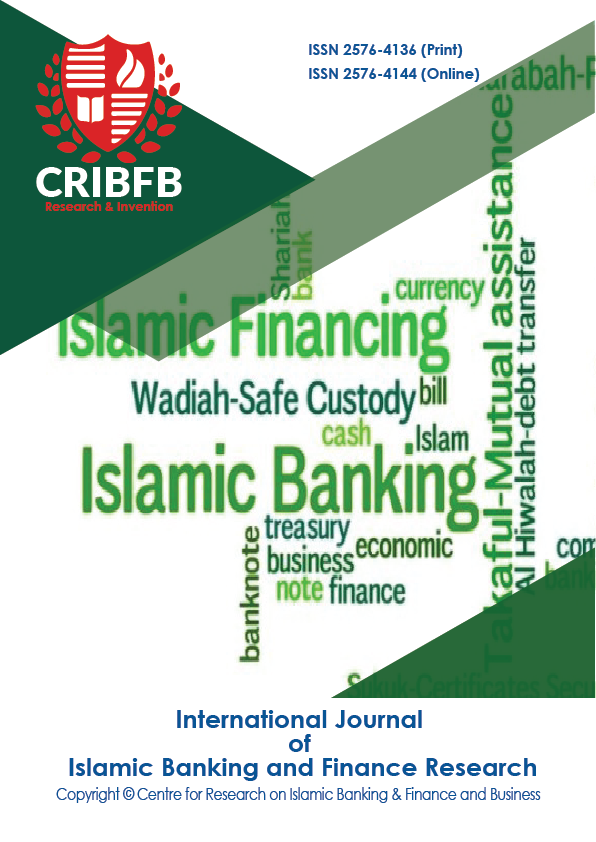THE EFFECT OF NON-PERFORMING FINANCING AND THIRD PARTY FUNDS ON THE PROFITABILITY THROUGH PS/RS AND PLS FINANCING
Main Article Content
Abstract
This research is motivated by the phenomenon of increasing PS/RS and PLS financing and profitability at Islamic Commercial Banks (BUS) in Indonesia during the 2015-2019 period, and experiencing a decline from 2019 to 2020. PS/RS and PLS financing can use mudharabah and musharakah contract schemes. Mudharabah financing is based on profit sharing, while Musharaka is based on profit-loss sharing. This study aims to obtain empirical evidence regarding the effect of non-performing financing and third-party funds on profitability through PS/RS and PLS financing. The population used in this study were all Islamic Commercial Banks in Indonesia in the 2015-2020 period. The data analysis technique used is Partial Least Square with SmartPLS software version 3. The results of the study found a direct effect of non-performing financing on profitability. The results of the study did not find a direct effect of non-performing financing on PS/RS and PLS financing. In addition, third party funds do not have a direct effect on profit-sharing and profitability-based financing. The results also did not find an indirect effect of non-performing financing and third-party funds on profitability.
JEL Classification Codes: A19, B10, B25, C10, C53.
Downloads
Article Details
Section
How to Cite
References
Al Arif, M. N. R., & Nurhikmah, I. (2017). Determinan Pembiayaan Bagi Hasil Perbankan Syariah di Indonesia. Al-Falah: Journal of Islamic Economics, 2(1), 1-12.
Amelia, E., & Hardini, E. F. (2017). Determinant of Mudharabah Financing: A Study at Indonesian Islamic Rural Banking. Etikonomi, 16(1), 43-52.
Darma, E. S., & Rita, R. (2011). Faktor-Faktor Yang Berpengaruh terhadap Tingkat Pengguliran Dana Bank Syariah. Journal of Accounting and Investment, 12(1), 72-87.
Diana, N., & Huda, S. (2019). Dana Pihak Ketiga dan Pendapatan Pembiayaan Bagi Hasil Terhadap Laba Pada Bank Umum Syariah Indonesia. Jurnal Akuntansi: Kajian Ilmiah Akuntansi, 6(1), 99-113.
Giannini, N. G. (2013). Faktor yang mempengaruhi pembiayaan Mudharabah pada bank umum syariah di Indonesia. Accounting Analysis Journal, 2(1).
Hair, J. F., Ringle, C. M., & Sarstedt, M. (2011). PLS-SEM: Indeed a Silver Bullet. Journal of Marketing Theory and Practice, 19(2), 139-151. https://doi.org/10.2753/MTP1069-6679190202.
Husaeni, U. A. (2017). Determinan Pembiayaan Pada Bank Pembiayaan Rakyat Syariah di Indonesia. Esensi: Jurnal Bisnis dan Manajemen, 7(1), 49-62. https://doi.org/10.15408/ess.v7i1.4542.
Hermuningsih, S. (2019). Third Party Funds and Indonesia's Sharia Banking Profitability with Revenue Sharing as Intervening Variable. East African Scholars Journal of Economics, Business and Management, 2(4), 242-251.
Jatmiko, U., Srikalimah & Fitriyanto, D. (2017). Effect of Capital Adequacy Ratio and Non Performing Financing on Return on Asset In PT. Bank Rakyat Indonesia (BRI) Syariah Period 2012-2016. International Journal of Social Science and Business, 1(4), 222-228. http://dx.doi.org/10.23887/ijssb.v1i4.12038.
Kinanti, R. A. & Purwohandoko, P. (2017). Influence of Third-Party Funds, CAR, NPF, and FDR towards the Return on Assets of Islamic Banks in Indonesia. Jurnal Ilmiah Bidang Akuntansi dan Manajemen (JEMA), 14(2), 135-143. http://dx.doi.org/10.31106/jema.v14i02.524.
Nurdiansyah, D. H., Ruchjana, E. T., & Fahrunnisa, S. (2020). The Influence of Third Party Funds and Profit Sharing Rate on Profit Sharing Funding. Jurnal Riset Akuntansi, 10(1), 1-10. https://doi.org/10.36733/juara.v10i1.747.
Rizal, F. (2016). Pengaruh Capital Adequacy Ratio, Non Performing Finance dan Operational Efficiency Ratio Terhadap Profitabilitas Bank Pembiayaan Rakyat Syariah. Muslim Heritage, 1(1), 179-196. https://doi.org/10.21154/muslimheritage.v1i1.501
Rizal, F., & Rofiqo, A. (2020). Determinants of Sharia Banking Profitability: Empirical Studies in Indonesia 2011-2020. el Barka: Journal of Islamic Economic and Business, 3(1), 137-161.
Salman, K. R. (2017). Akuntansi Perbankan Syariah Berbasis PSAK Syariah. Jakarta: Penerbit Indeks.
Salman, K. R. (2020). Akuntansi Syariah: Pendekatan Akad dan Wa'd. Depok: Penerbit Rajawali Pers.
Sarasi, V., Helmi, A., & Lisdiyanti, M. N. (2020). Pengaruh Pembiayaan Jual Beli, Bagi Hasil, Sewa-Menyewa Dan Non Performing Financing Terhadap Profitabilitas Bank Umum Syariah Di Indonesia Periode 2016–2018. Jurnal Ekonomi dan Bisnis Islam, 10(2), 1-10.
Sholikhah, Z., Pramuka, B. A., & Adawiyah, W. R. (2017). Determinant of Equity Based Financing Volume: A Case of Islamic Banks in Indonesia. Research Journal of Finance and Accounting, 8(1), 30-39.
Sutrisno, S. (2020). Islamic Banks's Risks and Profitability A Case Study on Islamic Banks in Indonesia. Kinerja, 24(1), 57-65.
Umiyati, U., & Syarif, S. M. (2016). Kinerja Keuangan dan Tingkat Bagi Hasil Deposito Mudharabah Pada Bank Umum Syariah Di Indonesia. Jurnal Akuntansi dan Keuangan Islam, 4(1), 45- 66.
Wahab, W. (2014). Analisis Pengaruh FDR, NPF, Tingkat Bagi Hasil, Kualitas Jasa, dan Atribut Produk Islam Terhadap Tingkat Pembiayaan Mudharabah Pada Bank Umum Syariah di Semarang. Economica, 5(2), 107-136.
Wahyudi, A. (2016). Determinan Pembiayaan Murabahah Pada Unit Usaha Syariah: Model Regresi Panel. Esensi: Jurnal Bisnis dan Manajemen, 6(2), 227-236.
Wirman, W. (2017). Analisis Pembiayaan Berbasis Bagi Hasil dan Rasio BOPO pada Perbankan Syariah di Indonesia. Accounthink: Journal of Accounting and Finance, 2(2), 377-388.




